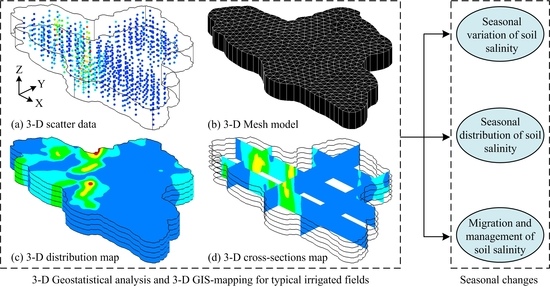Identifying Seasonal Accumulation of Soil Salinity with Three-Dimensional Mapping—A Case Study in Cold and Semiarid Irrigated Fields
Abstract
1. Introduction
2. Materials and Methods
2.1. Study Site
2.2. Soil Sampling and Laboratory Analysis
2.3. Geostatistical Analysis and Mapping Methods
2.4. Statistical Evaluation
3. Results
3.1. 3-D Analyses of Soil Samples
3.2. Descriptive Statistics and Geostatistical Analysis of Soil Salinity
3.3. Seasonal 3-D Variations of Soil Salinity
3.4. Seasonal Distribution of Soil Salinity in the Vertical Direction.
4. Discussion
4.1. Spatial Variation of Soil Salinity
4.2. Effects of Hydrological Processes on Soil Salinity
4.3. Effects of Topography on Soil Salinity
4.4. Management of Soil Water and Salt
5. Conclusions
Author Contributions
Funding
Acknowledgments
Conflicts of Interest
References
- Scudiero, E.; Skaggs, T.H.; Corwin, D.L. Comparative regional–scale soil salinity assessment with near–ground apparent electrical conductivity and remote sensing canopy reflectance. Ecol. Indic. 2016, 70, 276–284. [Google Scholar] [CrossRef]
- Xing, X.; Du, W.; Ma, X. Field–scale distribution and heterogeneity of soil salinity in the mulched–drip–irrigation cotton field. Arch. Agron. Soil Sci. 2019, 65, 1248–1261. [Google Scholar] [CrossRef]
- Bailey, R.T.; Tavakoli–Kivi, S.; Wei, X. A salinity module for SWAT to simulate salt ion fate and transport at the watershed scale. Hydrol. Earth Syst. Sc. 2019, 23, 3155–3174. [Google Scholar] [CrossRef]
- Connor, J.D.; Schwabe, K.; King, D.; Knapp, K. Irrigated agriculture and climate change: The influence of water supply variability and salinity on adaptation. Ecol. Econ. 2012, 77, 149–157. [Google Scholar] [CrossRef]
- Metternicht, G.I.; Zinck, J.A. Remote sensing of soil salinity: Potentials and constraints. Remote Sens. Environ. 2003, 85, 1–20. [Google Scholar] [CrossRef]
- Shao, H.; Chu, L.; Lu, H.; Qi, W.; Chen, X.; Liu, J.; Kuang, S.; Tang, B.; Won, V. Towards sustainable agriculture for the salt–affected soil. Land Degrad. Dev. 2019, 30, 574–579. [Google Scholar] [CrossRef]
- Bless, A.E.; Colin, F.; Crabit, A.; Devaux, N.; Philippon, O.; Follain, S. Landscape evolution and agricultural land salinization in coastal area: A conceptual model. Sci. Total Environ. 2018, 625, 647–656. [Google Scholar] [CrossRef]
- Shouse, P.J.; Goldberg, S.; Skaggs, T.H.; Soppe, R.W.O.; Ayars, J.E. Changes in spatial and temporal variability of SAR affected by shallow groundwater management of an irrigated field, California. Agr. Water Manag. 2010, 97, 673–680. [Google Scholar] [CrossRef]
- Li, X.; Chang, S.X.; Salifu, K.F. Soil texture and layering effects on water and salt dynamics in the presence of a water table: A review. Environ. Rev. 2014, 22, 41–50. [Google Scholar] [CrossRef]
- Xu, L.; Zheng, C.L.; Wang, Z.C.; Nyongesah, M.J. A digital camera as an alternative tool for estimating soil salinity and soil surface roughness. Geoderma 2019, 341, 68–75. [Google Scholar] [CrossRef]
- Bazihizina, N.; Barrett–Lennard, E.G.; Colmer, T.D. Plant growth and physiology under heterogeneous salinity. Plant Soil 2012, 354, 1–19. [Google Scholar] [CrossRef]
- Corwin, D.L.; Lesch, S.M. A simplified regional–scale electromagnetic induction – Salinity calibration model using ANOCOVA modeling techniques. Geoderma 2014, 230, 288–295. [Google Scholar] [CrossRef]
- Liu, W.; Lu, F.; Xu, X.; Chen, G.; Fu, T.; Su, Q. Spatial and temporal variation of soil salinity during dry and wet seasons in the southern coastal area of Laizhou Bay, China. Indian J. Geo–Mar. Sci. 2020, 49, 260–270. [Google Scholar]
- Nouri, H.; Borujeni, S.C.; Alaghmand, S.; Anderson, S.J.; Sutton, P.C.; Parvazian, S.; Beecham, S. Soil salinity mapping of urban greenery using remote sensing and proximal sensing techniques; the case of Veale Gardens within the Adelaide Parklands. Sustainability 2018, 10, 2826. [Google Scholar] [CrossRef]
- Wang, Y.; Deng, C.; Liu, Y.; Niu, Z.; Li, Y. Identifying change in spatial accumulation of soil salinity in an inland river watershed, China. Sci. Total Environ. 2018, 621, 177–185. [Google Scholar] [CrossRef]
- Liu, F.; Zhang, G.-L.; Song, X.; Li, D.; Zhao, Y.; Yang, J.; Wu, H.; Yang, F. High–resolution and three–dimensional mapping of soil texture of China. Geoderma 2020, 361, 114061. [Google Scholar] [CrossRef]
- Liu, W.; Xu, X.; Lu, F.; Cao, J.; Li, P.; Fu, T.; Chen, G.; Su, Q. Three–dimensional mapping of soil salinity in the southern coastal area of Laizhou Bay, China. Land Degrad. Dev. 2018, 29, 3772–3782. [Google Scholar] [CrossRef]
- Zare, E.; Beucher, A.; Huang, J.; Boman, A.; Mattback, S.; Greve, M.H.; Triantafilis, J. Three–dimensional imaging of active acid sulfate soil using a DUALEM–21S and EM inversion software. J Environ. Manag. 2018, 212, 99–107. [Google Scholar] [CrossRef]
- Zhang, S.; Zhang, L.; Li, Z.; Wang, Q.; Cui, H.; Sun, Z.; Ge, C.; Liu, H.; Huang, Y. Three–dimensional stochastic simulations of soil clay and its response to sampling density. Comput. Electron. Agr. 2017, 142, 273–282. [Google Scholar]
- Jiang, Q.; Peng, J.; Biswas, A.; Hu, J.; Zhao, R.; He, K.; Shi, Z. Characterising dryland salinity in three dimensions. Sci. Total Environ. 2019, 682, 190–199. [Google Scholar] [CrossRef]
- Van Meirvenne, M.; Maes, K.; Hofman, G. Three–dimensional variability of soil nitrate–nitrogen in an agricultural field. Biol. Fert. Soils 2003, 37, 147–153. [Google Scholar] [CrossRef]
- Triantafilis, J.; Laslett, G.M.; McBratney, A.B. Calibrating an electromagnetic induction instrument to measure salinity in soil under irrigated cotton. Soil Sci. Soc. Am. J. 2000, 64, 1009–1017. [Google Scholar] [CrossRef]
- Rhoades, J. Salinity: Electrical conductivity and total dissolved solids. In Methods of Soil Analysis: Part 3—Chemical Methods; Sparks, D.L., Ed.; Book Series No., 5; Soil Science Society of America: Madison, WI, USA, 1996; pp. 417–435. [Google Scholar]
- Goovaerts, P. Geostatistics in soil science: State–of–the–art and perspectives. Geoderma 1999, 89, 1–45. [Google Scholar] [CrossRef]
- Liebhold, A.M.; Rossi, R.E.; Kemp, W.P. Geostatistics and geographic information systems in applied insect ecology. Annu. Rev. Entomol. 1993, 38, 303–327. [Google Scholar] [CrossRef]
- Chen, C.; Hu, K.; Li, W.; Li, Z.; Li, B. Three–dimensional mapping of clay content in alluvial soils using hygroscopic water content. Environ. Earth Sci. 2015, 73, 4339–4346. [Google Scholar] [CrossRef]
- Liu, G.; Li, J.; Zhang, X.; Wang, X.; Lv, Z.; Yang, J.; Shao, H.; Yu, S. GIS–mapping spatial distribution of soil salinity for Eco–restoring the Yellow River Delta in combination with Electromagnetic Induction. Ecol. Eng. 2016, 94, 306–314. [Google Scholar] [CrossRef]
- Cambardella, C.A.; Moorman, T.B.; Novak, J.M.; Parkin, T.B.; Karlen, D.L.; Turco, R.F.; Konopka, A.E. Field–scale variability of soil properties in central Iowa soils. Soil Sci. Soc. Am. J. 1994, 58, 1501–1511. [Google Scholar] [CrossRef]
- Chien, Y.J.; Lee, D.Y.; Guo, H.Y.; Houng, K.H. Geostatistical analysis of soil properties of mid–west Taiwan soils. Soil Sci. 1997, 162, 291–298. [Google Scholar] [CrossRef]
- Li, H.Y.; Shi, Z.; Webster, R.; Triantafilis, J. Mapping the three–dimensional variation of soil salinity in a rice–paddy soil. Geoderma 2013, 195, 31–41. [Google Scholar] [CrossRef]
- Rengasamy, P. World salinization with emphasis on Australia. J. Exp. Bot. 2006, 57, 1017–1023. [Google Scholar] [CrossRef]
- Bargaz, A.; Nassar, R.M.A.; Rady, M.M.; Gaballah, M.S.; Thompson, S.M.; Brestic, M.; Schmidhalter, U.; Abdelhamid, M.T. Improved salinity tolerance by phosphorus fertilizer in two phaseolus vulgaris recombinant inbred lines contrasting in their P–efficiency. J. Agron. Crop Sci. 2016, 202, 497–507. [Google Scholar] [CrossRef]
- Yimit, H.; Eziz, M.; Mamat, M.; Tohti, G. Variations in groundwater levels and salinity in the Ili River Irrigation Area, Xinjiang, northwest China: A geostatistical approach. Int. J. Sust. Dev. World 2011, 18, 55–64. [Google Scholar] [CrossRef]
- Sidike, A.; Zhao, S.; Wen, Y. Estimating soil salinity in Pingluo County of China using QuickBird data and soil reflectance spectra. Int. J. Appl. Earth Obs. 2014, 26, 156–175. [Google Scholar] [CrossRef]
- Wang, Y.; Li, Y.; Xiao, D. Catchment scale spatial variability of soil salt content in agricultural oasis, Northwest China. Environ. Earth Sci. 2008, 56, 439–446. [Google Scholar] [CrossRef]
- Gebremeskel, G.; Gebremicael, T.; Kifle, M.; Meresa, E.; Gebremedhin, T.; Girmay, A. Salinization pattern and its spatial distribution in the irrigated agriculture of Northern Ethiopia: An integrated approach of quantitative and spatial analysis. Agr. Water Manag. 2018, 206, 147–157. [Google Scholar] [CrossRef]
- Wu, C.; Liu, Q.; Ma, G.; Liu, G.; Yu, F.; Huang, C.; Zhao, Z.; Liang, L. A study of the spatial difference of the soil quality of the Mun River Basin during the rainy season. Sustainability 2019, 11, 3423. [Google Scholar] [CrossRef]
- Dessalegn, D.; Beyene, S.; Ram, N.; Walley, F.; Gala, T.S. Effects of topography and land use on soil characteristics along the toposequence of Ele watershed in southern Ethiopia. Catena 2014, 115, 47–54. [Google Scholar] [CrossRef]
- Feike, T.; Khor, L.Y.; Mamitimin, Y.; Ha, N.; Li, L.; Abdusalih, N.; Xiao, H.; Doluschitz, R. Determinants of cotton farmers’ irrigation water management in arid Northwestern China. Agr. Water Manag. 2017, 187, 1–10. [Google Scholar] [CrossRef]
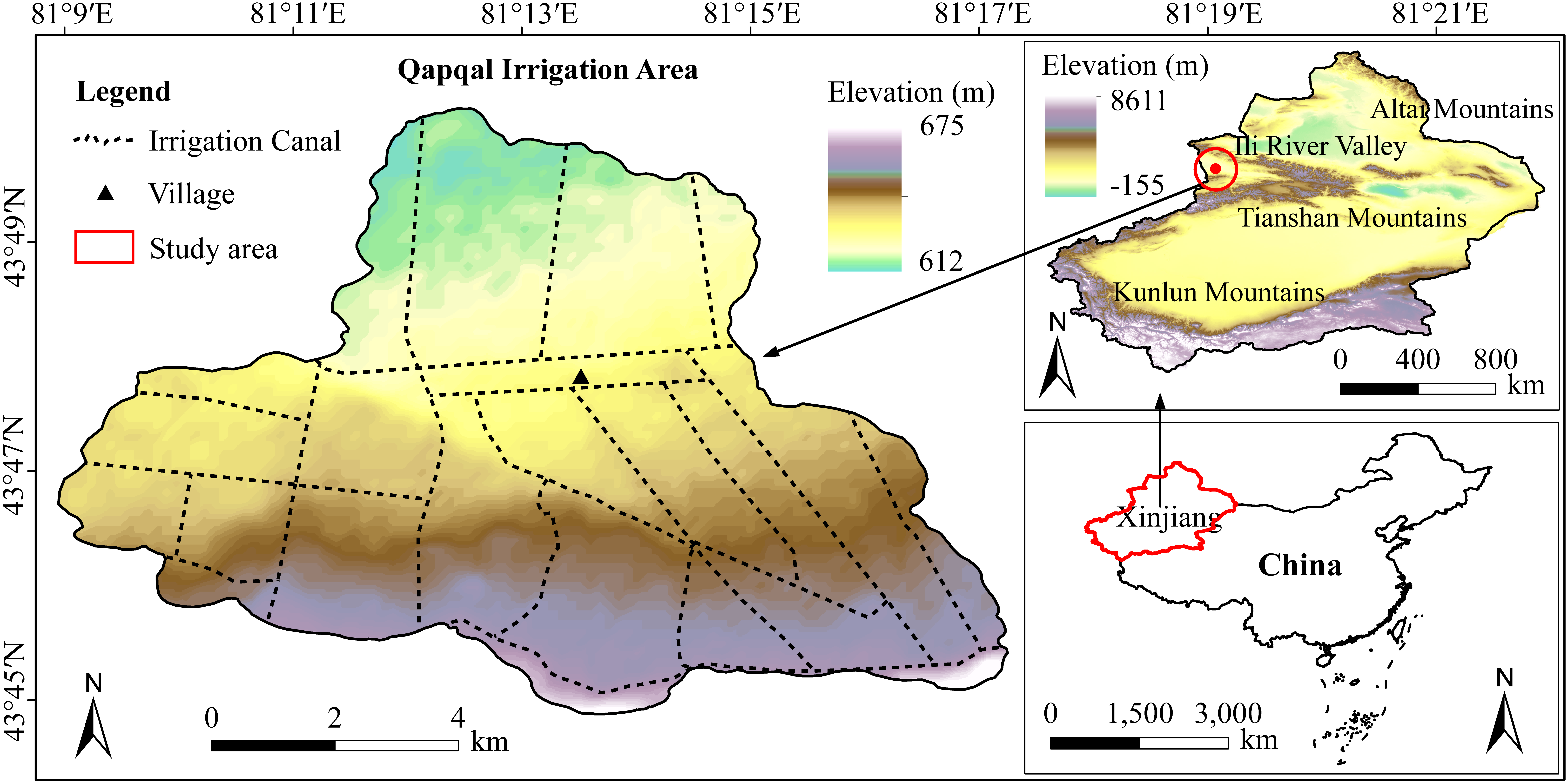

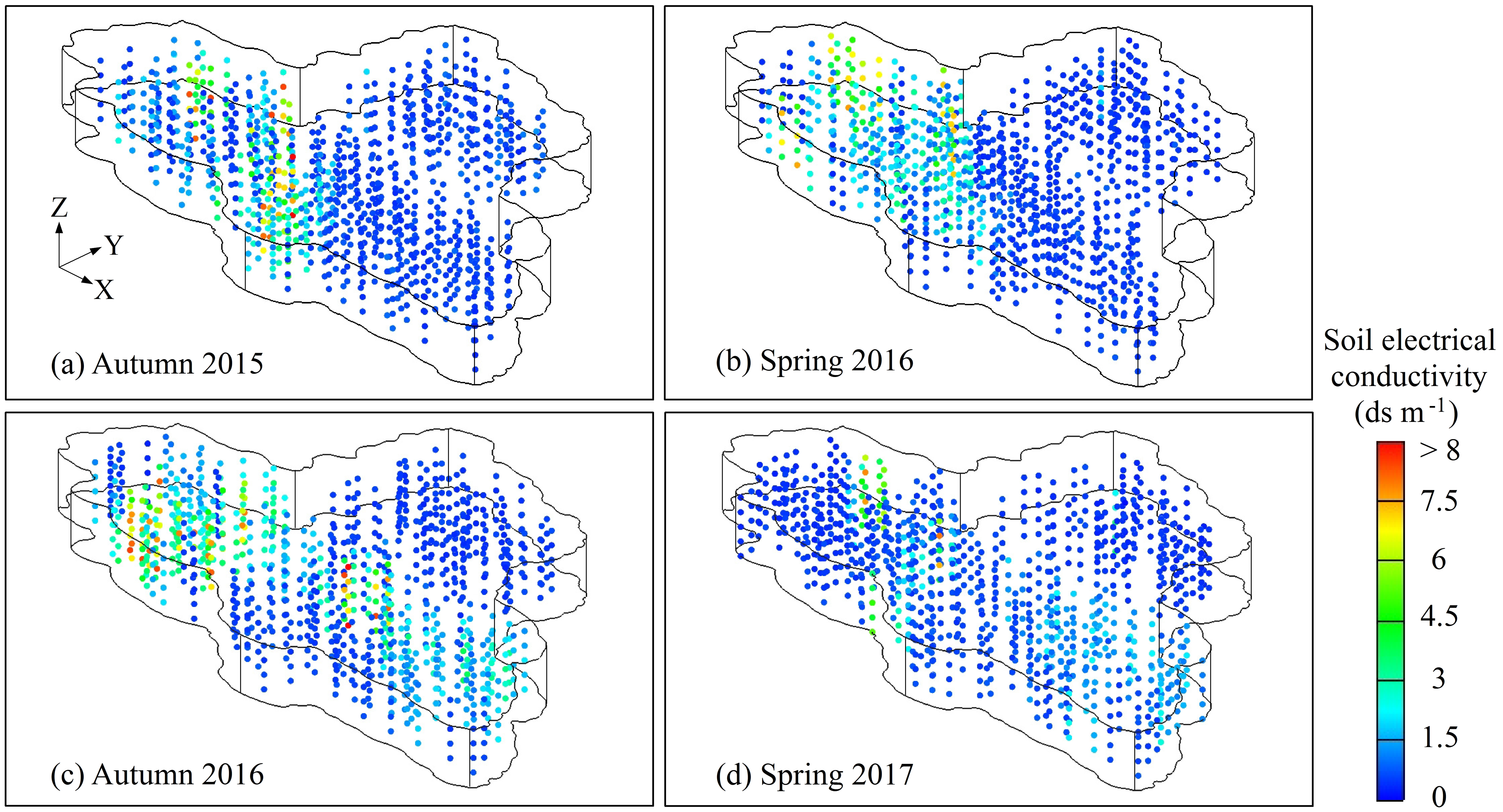
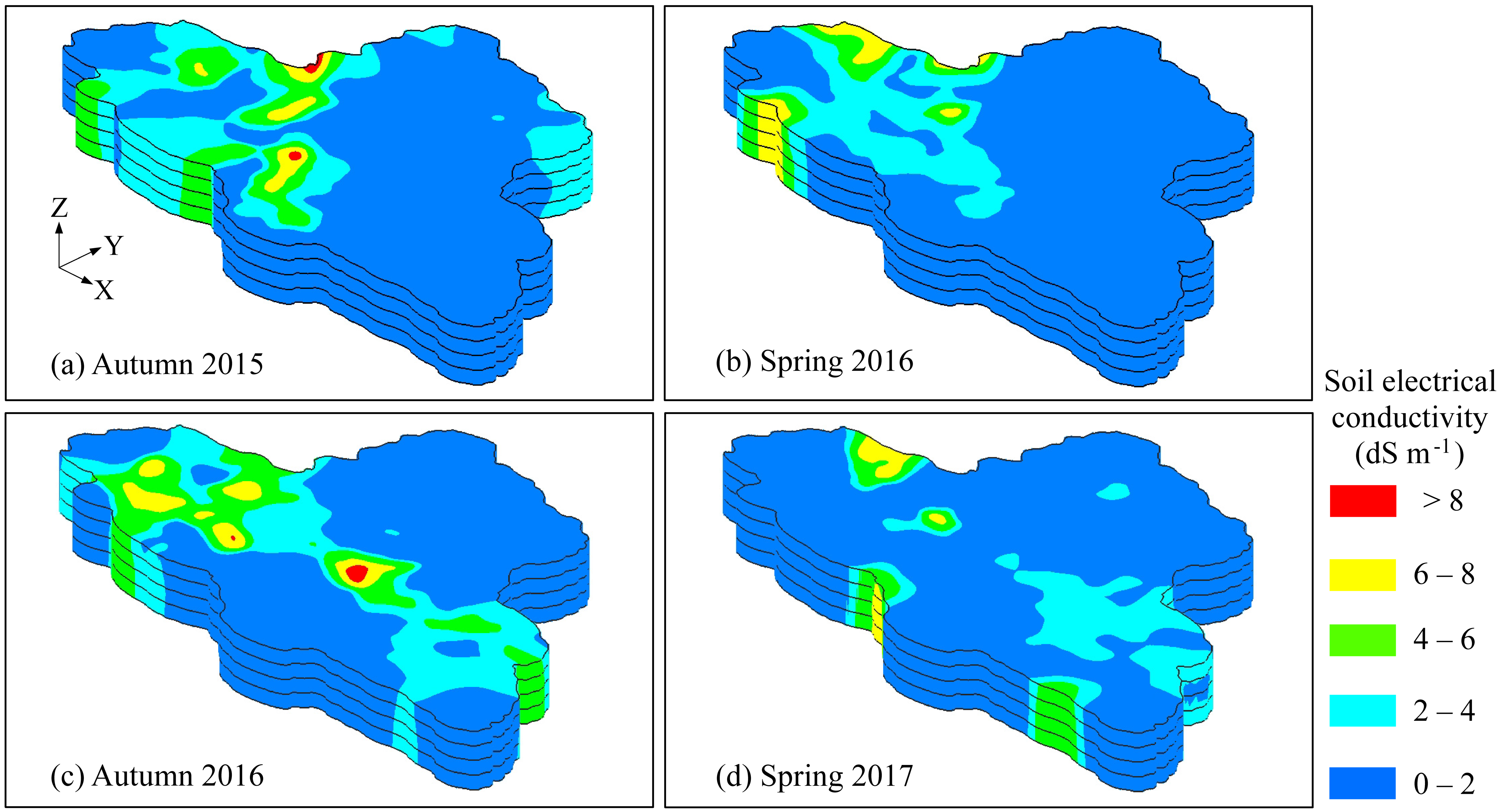
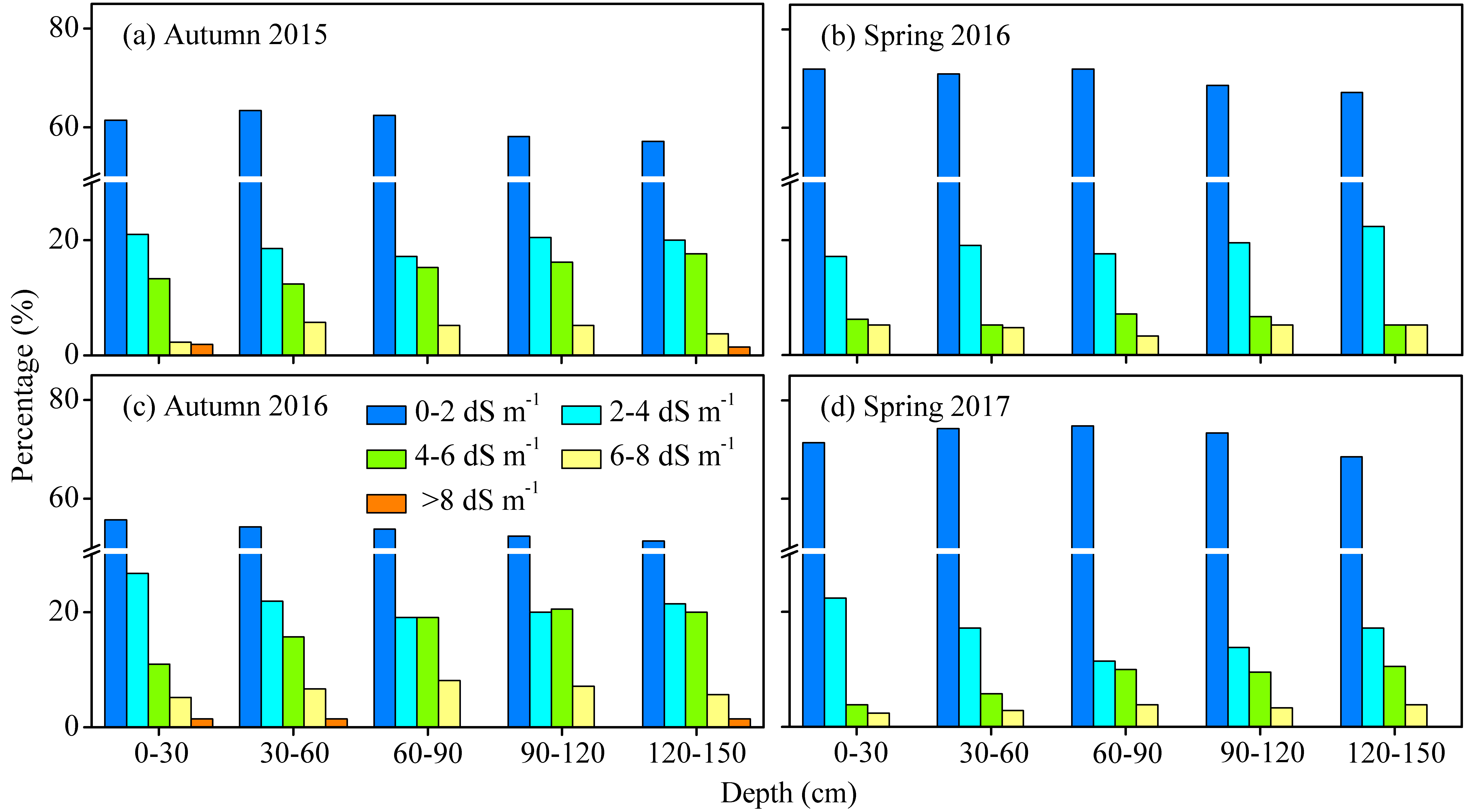
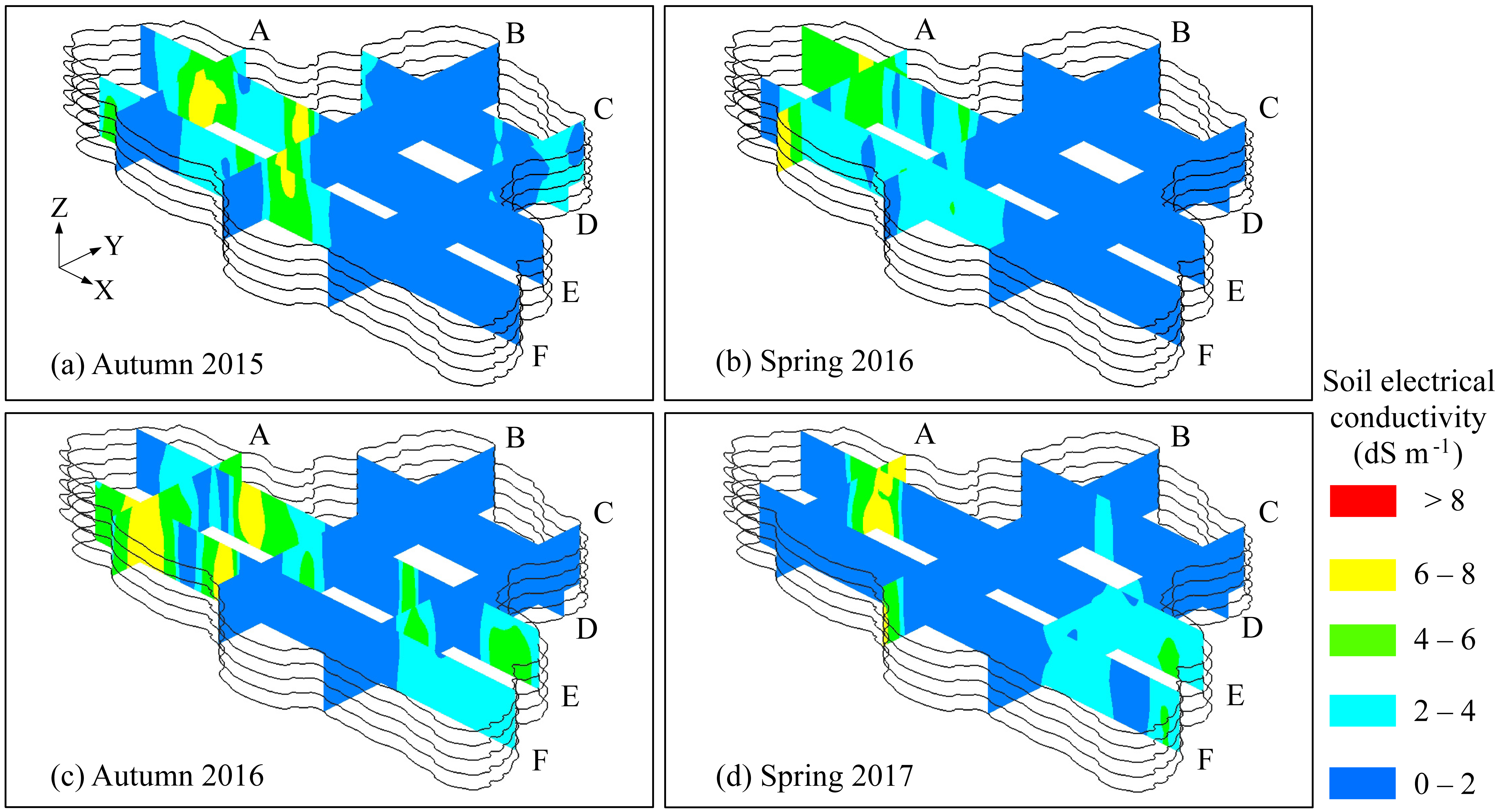
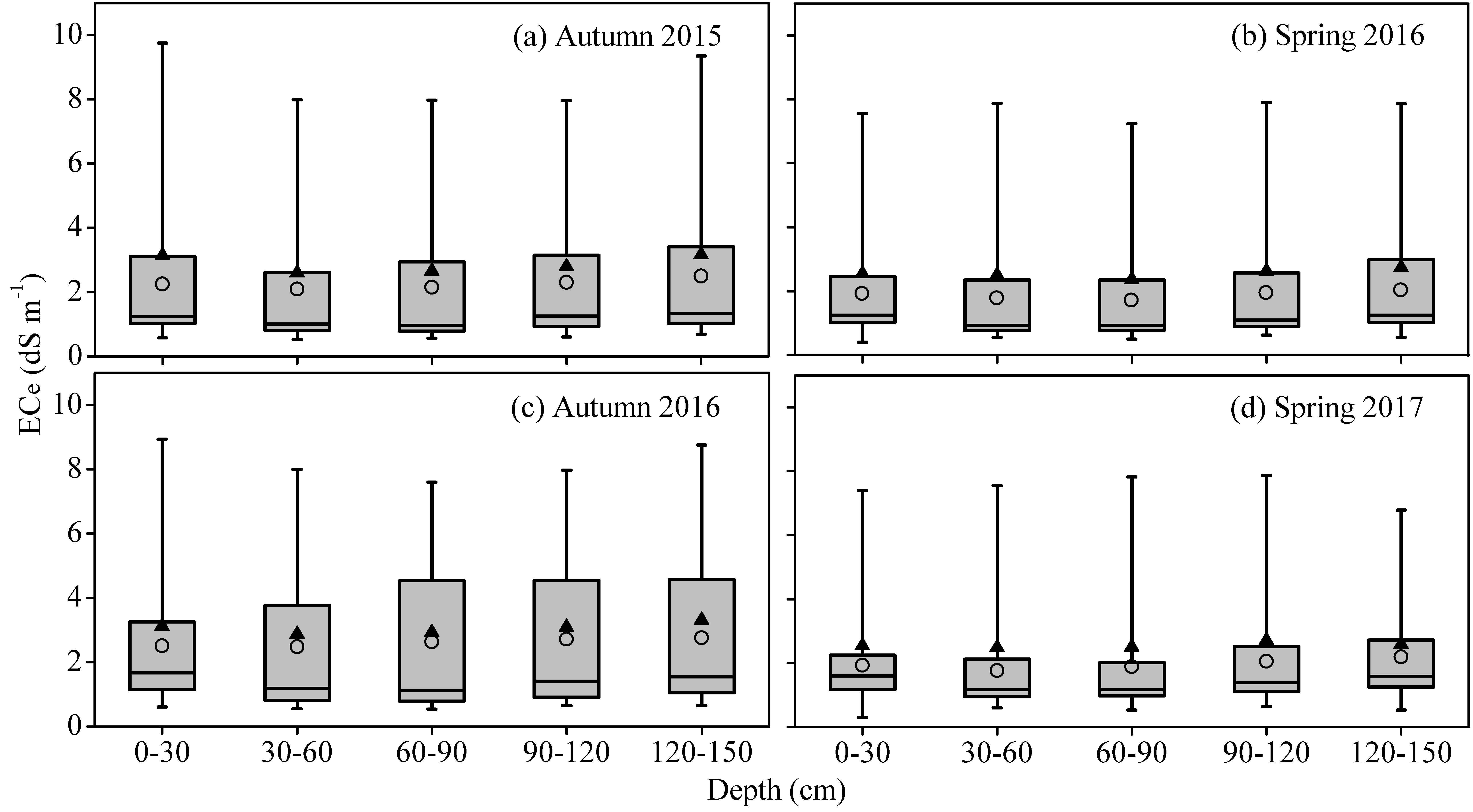
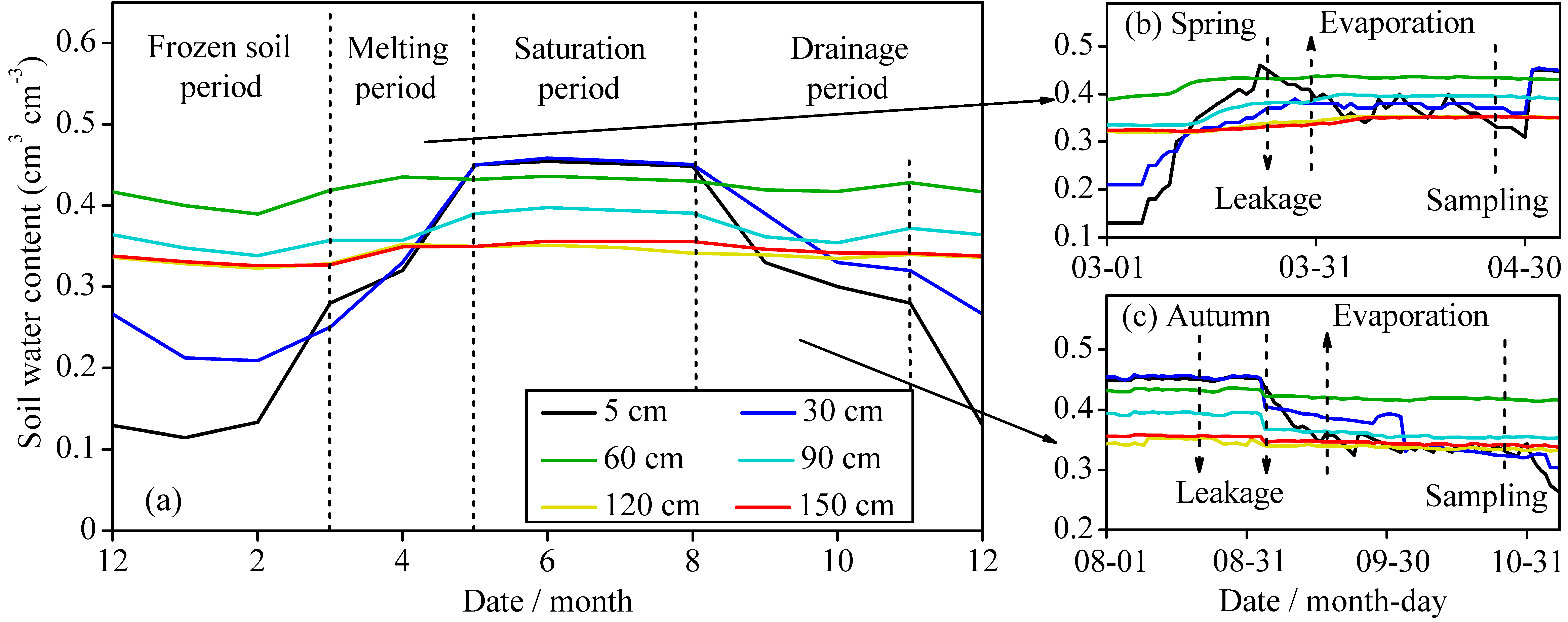
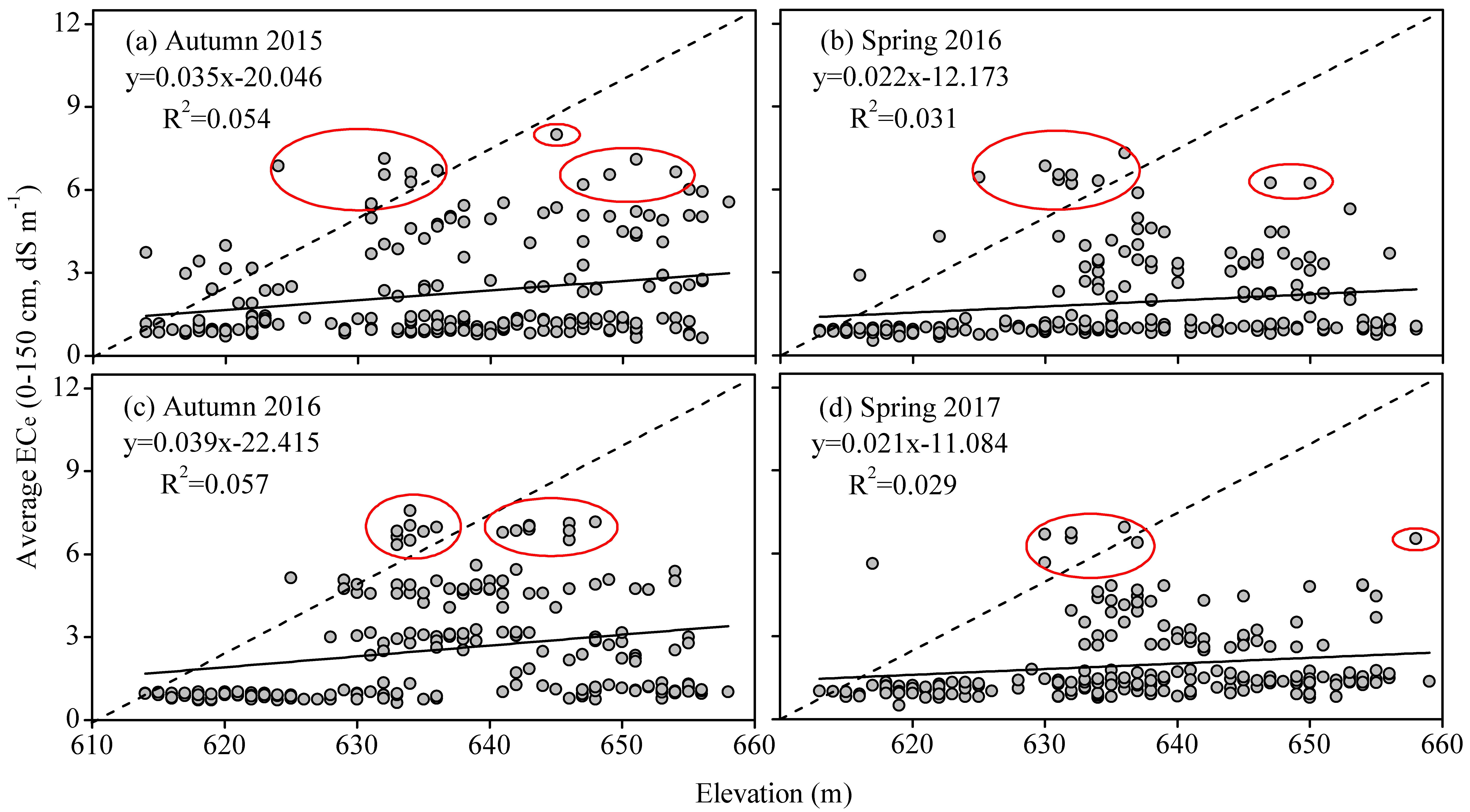
| Depth (cm) | Autumn 2015 | Spring 2016 | ||||||||
| 0–30 | 30–60 | 60–90 | 90–120 | 120–150 | 0–30 | 30–60 | 60–90 | 90–120 | 120–150 | |
| 0–30 | 1 | 1 | ||||||||
| 30–60 | 0.923 * | 1 | 0.931 * | 1 | ||||||
| 60–90 | 0.851 * | 0.922 * | 1 | 0.870 * | 0.893 * | 1 | ||||
| 90–120 | 0.836 * | 0.877 * | 0.941 * | 1 | 0.922 * | 0.913 * | 0.901 * | 1 | ||
| 120–150 | 0.834 * | 0.883 * | 0.911 * | 0.927 * | 1 | 0.912 * | 0.878 * | 0.882 * | 0.911 * | 1 |
| Depth (cm) | Autumn 2016 | Spring 2017 | ||||||||
| 0–30 | 30–60 | 60–90 | 90–120 | 120–150 | 0–30 | 30–60 | 60–90 | 90–120 | 120–150 | |
| 0–30 | 1 | 1 | ||||||||
| 30–60 | 0.932 * | 1 | 0.899 * | 1 | ||||||
| 60–90 | 0.907 * | 0.917 * | 1 | 0.826 * | 0.899 * | 1 | ||||
| 90–120 | 0.869 * | 0.863 * | 0.938 * | 1 | 0.900 * | 0.910 * | 0.942 * | 1 | ||
| 120–150 | 0.906 * | 0.851 * | 0.925 * | 0.912 * | 1 | 0.785 * | 0.885 * | 0.881 * | 0.915 * | 1 |
| Time | Sample Size | Max. | Min. | Average | Standard Deviation | CV (%) | Skewness | Kurtosis | K–S Test |
|---|---|---|---|---|---|---|---|---|---|
| Autumn 2015 | 210 | 7.99 | 0.65 | 2.26 | 1.80 | 80 | 1.26 | 1.35 | 0.31 |
| Spring 2016 | 210 | 7.32 | 0.53 | 1.90 | 1.56 | 82 | 1.67 | 1.99 | 0.21 |
| Autumn 2016 | 210 | 7.57 | 0.63 | 2.57 | 1.95 | 76 | 0.89 | 0.58 | 0.60 |
| Spring 2017 | 210 | 6.94 | 0.51 | 1.96 | 1.39 | 71 | 1.75 | 2.45 | 0.47 |
| Time | Model | C0 | C0 + C | C0/(C0 + C) | Range (km) | RMSE | R2 |
|---|---|---|---|---|---|---|---|
| Autumn 2015 | Gaussian | 1.612 | 6.509 | 0.248 | 0.667 | 1.427 | 0.748 |
| Spring 2016 | Gaussian | 0.243 | 4.110 | 0.059 | 0.476 | 1.073 | 0.808 |
| Autumn 2016 | Gaussian | 1.320 | 5.604 | 0.236 | 0.420 | 1.260 | 0.817 |
| Spring 2017 | Gaussian | 0.529 | 4.266 | 0.124 | 0.714 | 0.975 | 0.795 |
© 2020 by the authors. Licensee MDPI, Basel, Switzerland. This article is an open access article distributed under the terms and conditions of the Creative Commons Attribution (CC BY) license (http://creativecommons.org/licenses/by/4.0/).
Share and Cite
Liu, Q.; Hanati, G.; Danierhan, S.; Liu, G.; Zhang, Y.; Zhang, Z. Identifying Seasonal Accumulation of Soil Salinity with Three-Dimensional Mapping—A Case Study in Cold and Semiarid Irrigated Fields. Sustainability 2020, 12, 6645. https://doi.org/10.3390/su12166645
Liu Q, Hanati G, Danierhan S, Liu G, Zhang Y, Zhang Z. Identifying Seasonal Accumulation of Soil Salinity with Three-Dimensional Mapping—A Case Study in Cold and Semiarid Irrigated Fields. Sustainability. 2020; 12(16):6645. https://doi.org/10.3390/su12166645
Chicago/Turabian StyleLiu, Qianqian, Gulimire Hanati, Sulitan Danierhan, Guangming Liu, Yin Zhang, and Zhiping Zhang. 2020. "Identifying Seasonal Accumulation of Soil Salinity with Three-Dimensional Mapping—A Case Study in Cold and Semiarid Irrigated Fields" Sustainability 12, no. 16: 6645. https://doi.org/10.3390/su12166645
APA StyleLiu, Q., Hanati, G., Danierhan, S., Liu, G., Zhang, Y., & Zhang, Z. (2020). Identifying Seasonal Accumulation of Soil Salinity with Three-Dimensional Mapping—A Case Study in Cold and Semiarid Irrigated Fields. Sustainability, 12(16), 6645. https://doi.org/10.3390/su12166645



